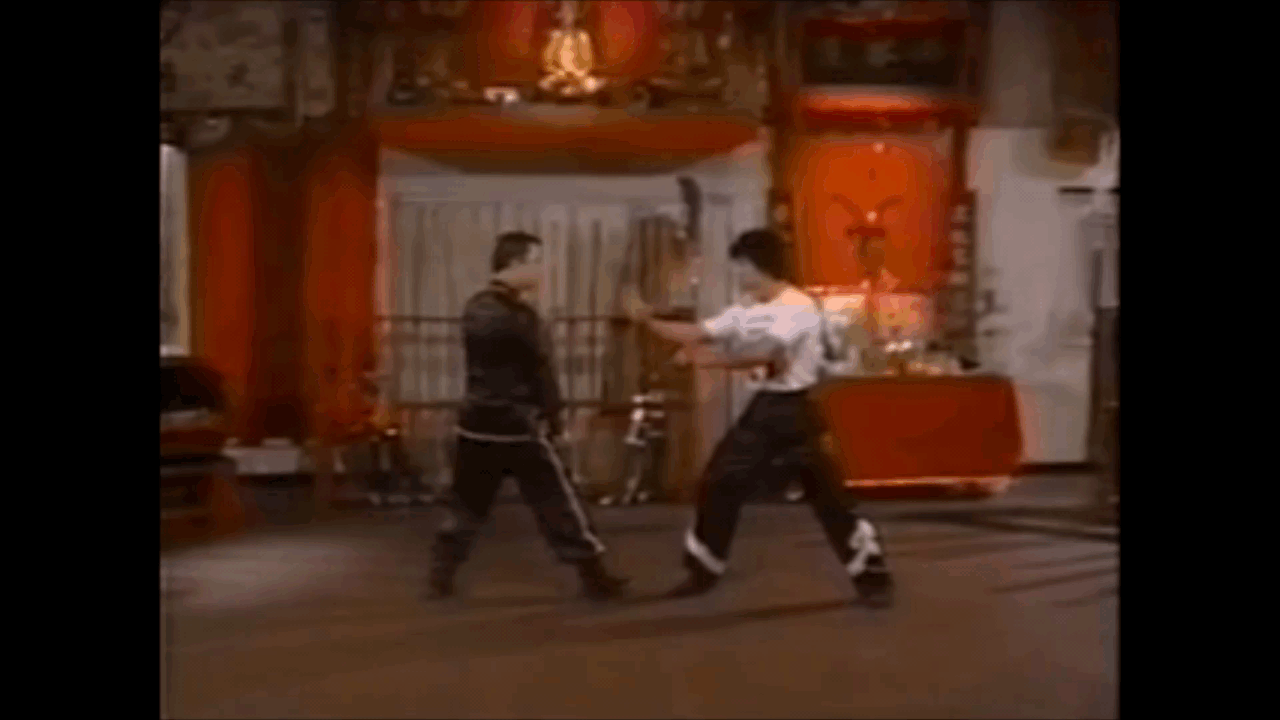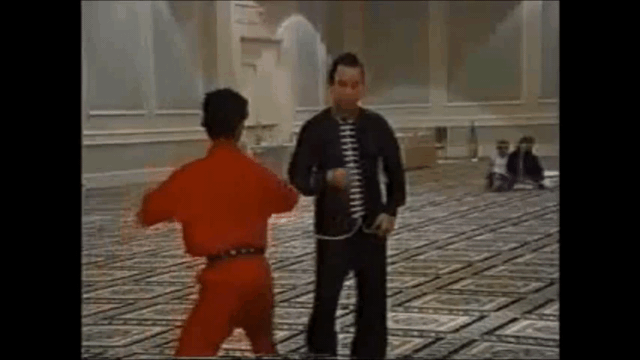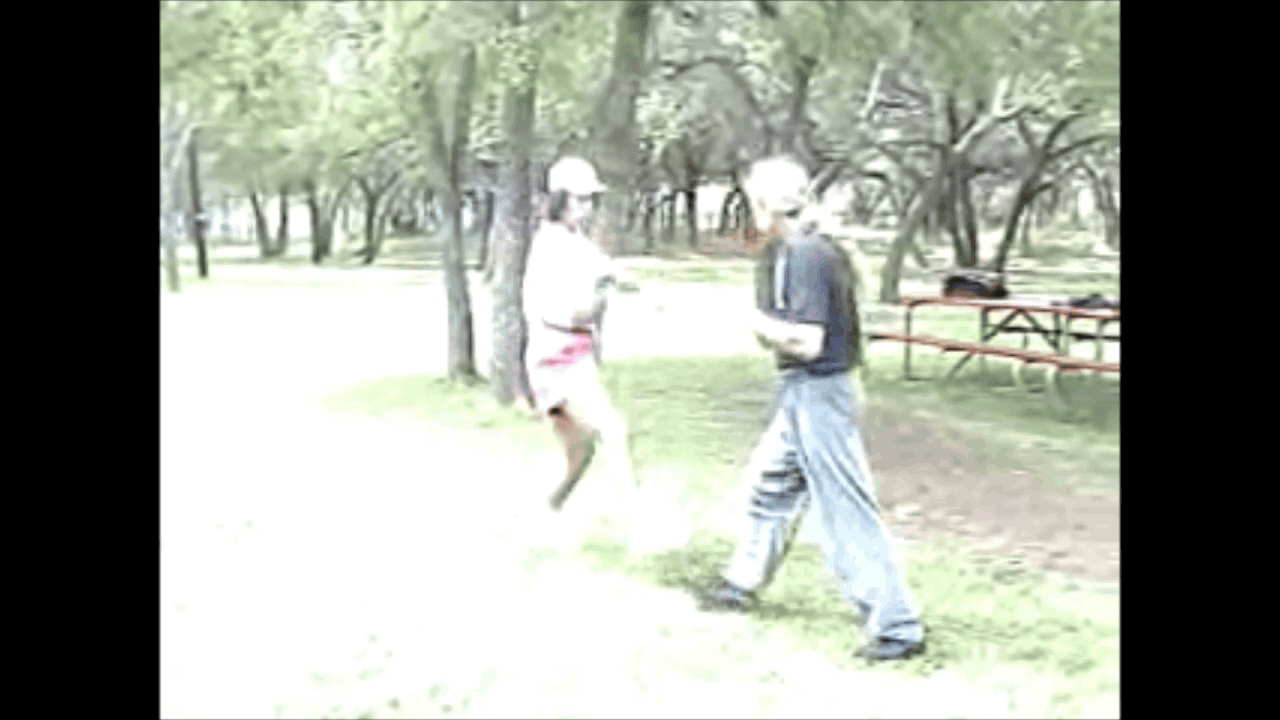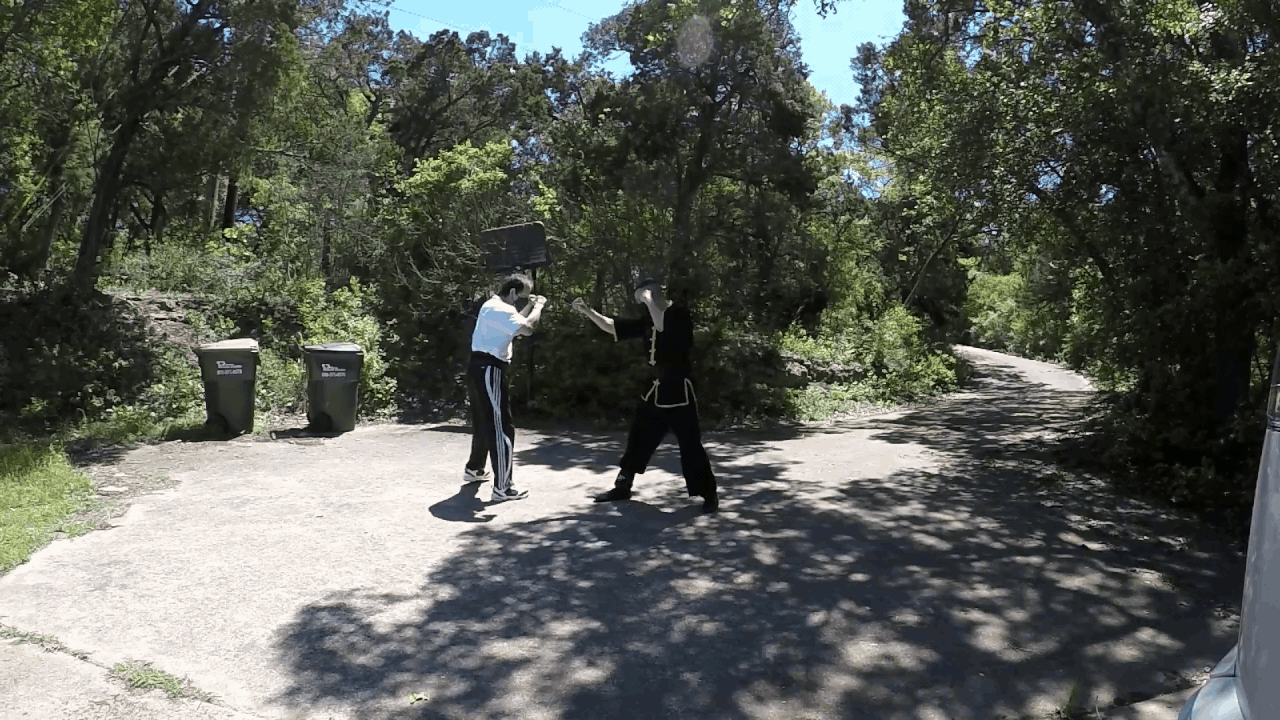I'm not sure you can.You can lead a horse to water…
Navigation
Install the app
How to install the app on iOS
Follow along with the video below to see how to install our site as a web app on your home screen.
Note: This feature may not be available in some browsers.
More options
Style variation
You are using an out of date browser. It may not display this or other websites correctly.
You should upgrade or use an alternative browser.
You should upgrade or use an alternative browser.
The layered bunkai theory is stupid
- Thread starter GojuTommy
- Start date
Then you're reading with the intent to misread.It’s what you said, no exaggeration.
This is how I understand it as well. The same way people from different system apply the same movement differently. There is no one way to pull. The shape of a pull changes depending on the level applied. Kow Ga has pulls where we don't grab the opponent. If the opponent grabs my wrist then I can pull him by pulling my hand back empty.I’m only aware of one reference made to Funakoshi in this regard, and that was him discussing a specific application, which may or may not be the overall definition of the term. My point stands that you are making linguistic arguments based on a translation of a term.
But if he uses pulling in the context grappling in Judo then that's how he will define pulling. In striking pulling is not the same as in Judo because it doesn't require me to grab anything. Most of the time it's pulling done to escape or redirect strikes so that you can counter strike.
In CMA, most of the time, the purpose of block/grab/pull is for "switch hands". You attack your opponent with your leading hand (not your back hand). When you apply "switch hands", since you are in your opponent's side door, your opponent's leading arm can jam his own back arm, you don't have to worry about his back hand punch. The more you pull, the harder your opponent can punch you with his other arm.But if he uses pulling in the context grappling in Judo then that's how he will define pulling. In striking pulling is not the same as in Judo because it doesn't require me to grab anything. Most of the time it's pulling done to escape or redirect strikes so that you can counter strike.
We just don't see 'switch hands" used in the MMA fight. In another 100 years, the principle of "switch hands" may disappear from the face of the earth.




Last edited:
Jow Ga does a lot of pull where don't switch hands. Then we have have pulling where we pull and strike with the same hand. I posted images of me doing this. The video of Jab Back fist has a thrid technique (pull + escape grab). We are taught the defense version but the offense version is just jab black fist. We also have scoops that pull which are uses against straight punches and straight kicks. Then there's a pull that we do with the long fist striking arm. Then there's pulls done from trapping.In CMA, most of the time, the purpose of block/grab/pull is for "switch hands". When you apply "switch hands", since you are in your opponent's side door, your opponent's leading arm can jam his own back arm, you don't have to worry about his back hand punch. The more you pull, the harder your opponent can punch you with his other arm.
We just don't see 'switch hands" used in the MMA fight. In another 100 years, the principle of "switch hands" may disappear from the face of the earth.

This is why I resist thinking that pull only means one thing. If someone catches our front kick then we pull that leg back with force to escape. This also pulls our opponent off balance. There or just a lot of ways other than grab clothing or arm then pull.
We are like 2 sides of the same coin. Your application leads to grappling mine leads to strikingIn CMA, most of the time, the purpose of block/grab/pull is for "switch hands". You attack your opponent with your leading hand (not your back hand). When you apply "switch hands", since you are in your opponent's side door, your opponent's leading arm can jam his own back arm, you don't have to worry about his back hand punch. The more you pull, the harder your opponent can punch you with his other arm.
We just don't see 'switch hands" used in the MMA fight. In another 100 years, the principle of "switch hands" may disappear from the face of the earth.

After looking at the Jow Ga video and seeing how the technique takes into account that they are opened to the head when the guard is low,
I decided to see what other systems uses the chamber at the waist and I saw that Savate uses it as well. Just like in Jow Ga, Savate directs a follow up technique to the open side where the guard is down. At the moment I I'm thinking that the fist to the waist is also serving as an invite. Two systems that seem to know that they are open there both send a defense technique in which they can counter off of. I have to check out some more videos of other systems. To see if I see similar concepts. I've only seen 2 videos but It looks like they want someone to punch them at that angle. Which lines up with I was saying. If it' chambered at the waist then have it there for a purpose.
I even saw a technique straight out of Jow Ga Kung fu. Scoop pull- thrust punch. Literally the same concept of technique with the exception that they shifted into bow but Jow Ga steps into horse.
I decided to see what other systems uses the chamber at the waist and I saw that Savate uses it as well. Just like in Jow Ga, Savate directs a follow up technique to the open side where the guard is down. At the moment I I'm thinking that the fist to the waist is also serving as an invite. Two systems that seem to know that they are open there both send a defense technique in which they can counter off of. I have to check out some more videos of other systems. To see if I see similar concepts. I've only seen 2 videos but It looks like they want someone to punch them at that angle. Which lines up with I was saying. If it' chambered at the waist then have it there for a purpose.
drop bear
Sr. Grandmaster
She did a couple of things wrong. You can drop your hands if you are in the right spot. You can be in the wrong spot and get out of it with a tight cover.Claressa Shields gets knocked down, when she throws a jab, cross, then drops (chambers) her right hand.

But you can't swing your head in to a punch with your hands down.
And hands down is bad foundational training as it is easier to teach a person to stay protected than it is to give them the fight I.Q to get away with having loose defences.
Now kata rarely delves in to this layered fighting theory where hands down works. So it probably shouldn't go hands down.
That's because Kata doesn't teach how to apply the techniques. We see people who know 5 different katas but when when it comes to actually fighting we don't see the techniques that they train in Kata.Now kata rarely delves in to this layered fighting theory where hands down works. So it probably shouldn't go hands down.
Sparring is where it's at. Anything that is done in sparring carries over in fighting very easily. Sparring is where good foundation for application is trained. Kata / Forms is like a good foundation for mechanics.
Think of it like a car. If you want to focus on the mechanics of the wheel, then you can do so without having to race the car. But if you want to actually apply those mechanics in actual use, then you'll do a couple of test laps and fine tune before racing. That's what kata and forms are like. Kata is the workshop, sparring is the test lap, then once everything works there. It can be applied to racing.
When people say that fist on the waist in kata will create bad habits.
You can do stuff like this a million times
but when it come to actual use. Those techniques are no where to be seen. I bet this guy train a lot of Kung fu that probably looks awesome in forms but it's no where to be seen. If the only way to know it's kung fu is by the title, then you don't have worry about kung fu forms or kata becoming habit lol.
As long as we don't develop bad habits when we are doing sparing of any type at any intensity, then we should be ok.. If the guys in the video keep doing bad habit here, then it will be a bad thing in a fight. The risk is the getting away with a bad habit. So karate vs karate only punching to the body starts create habits that aren't good for when punching to the head is allowed. TKD gets caught with this all the time.
I think the system may have forgotten how it works. I'm not saying that I know exactly how to use the chamber hand by the waist. I've only had limited success in a narrow range. The reason I think it was forgotten because the fist chambered on the waist is in other systems. Hopefully I can figure it out to the point where I can try it in sparring. At the moment I only know 2 things.Now kata rarely delves in to this layered fighting theory where hands down works. So it probably shouldn't go hands down.
1. Hand chambered on my hip.
2. My opponent will either try to kick me or punch me on that side.
What i need to know.
2. What type of strikes will come from that side and how do I narrow the possibilities so that I increase the chance that it will either be a kick or a punch.
3. Once I bait the type of strike that I expect to come, then what do I do next. I can't just block. It will have to be a block and counter. Or 2 blocks. One for the first strike and another for the follow up strike.
Maybe I'll get some ideas of what Jow Ga techniques I can use. I don't know the one the boy was training so I would have to learn that first or choose another..
drop bear
Sr. Grandmaster
Does that guy actually bare knuckle box. Or is he one of those theoretical bare knuckle boxers?Since we are talking about the guard. Here's another perspective. I just found this one.
drop bear
Sr. Grandmaster
Then the kata would reflect that.I think the system may have forgotten how it works. I'm not saying that I know exactly how to use the chamber hand by the waist. I've only had limited success in a narrow range. The reason I think it was forgotten because the fist chambered on the waist is in other systems. Hopefully I can figure it out to the point where I can try it in sparring. At the moment I only know 2 things.
1. Hand chambered on my hip.
2. My opponent will either try to kick me or punch me on that side.
What i need to know.
2. What type of strikes will come from that side and how do I narrow the possibilities so that I increase the chance that it will either be a kick or a punch.
3. Once I bait the type of strike that I expect to come, then what do I do next. I can't just block. It will have to be a block and counter. Or 2 blocks. One for the first strike and another for the follow up strike.
Maybe I'll get some ideas of what Jow Ga techniques I can use. I don't know the one the boy was training so I would have to learn that first or choose another..
isshinryuronin
Senior Master
Why are there high school teachers when the students have textbooks? They put things in context and elaborate so the students get understanding. Kata doesn't teach how to apply the techniques, just like it doesn't really teach any move - That's what the teacher is for. Unfortunately, like in the public schools, there are a lot of teachers who lack a high understanding of the material and simply read aloud from the book and have the kids memorize the information to spit back on a test. Too often this is true in karate kata.That's because Kata doesn't teach how to apply the techniques.
Yes, this is very common and several reasons for this. The first is related to the above quote - the teacher does not know the fighting applications of the kata techniques.We see people who know 5 different katas but when when it comes to actually fighting we don't see the techniques that they train in Kata.
Secondly, depending on the kata, perhaps 1/3 of the moves are not able to be safely executed in sparring, or if safe, not considered a valid point.
Thirdly, karate (and its kata) was not created for sport sparring or fighting other karateka, but rather for close-in self-defense with the aim of ending the engagement ASAP.
And fourthly, many TMA practitioners just haven't explored the kata to extract those moves that could be used in sparring. If one reviews their kata for fighting/sparring applications some will be found. Over the past century, with the advent of competition, the mindset has been that kata and fighting are two completely different things.
I have personally used a few kata techniques seldom seen in sparring and have been quite successful in landing them. Part of this success (aside from my blinding speed and impeccable timing) is that my opponent has never seen such moves in a match. I will go into a match with two or three kata techniques (besides simple punches or front kick) in mind and try to score with them. If you do this with the right moves, you may be surprised.
I don't mind requesting a beginner to train TMA forms. I won't suggest an advance student to still train the TMA forms. After a beginner has developed the foundation from TMA form training, he should move on.That's because Kata doesn't teach how to apply the techniques. We see people who know 5 different katas but when when it comes to actually fighting we don't see the techniques that they train in Kata.
The advance student should train something like the following (or some similar combo) with fast forward footwork:
- right front kick (linear),
- left roundhouse kick (circular),
- left jab (linear),
- right cross (linear),
- left hook (circular),
- right uppercut (circular).
The reason is simple. You can just repeat this combo in sparring. Your combo will keep your opponent busy (put him in defense mode). After you have repeated this combo 10,000 times in sparring, most people won't be able to escape from your continuous attack.
Your attack is like a machine gun that shoot out 6 bullets. You hope at least 1 of those 6 bullets can hit on your opponent. It's much more fun to train this way then just to train 1 punch at a time, or 1 kick at a time.
Last edited:
I can't remember. I've seen some of his other videos and those were accurate. I guess we'll have to check out some bareknucke videos to see what guard they use.Does that guy actually bare knuckle box. Or is he one of those theoretical bare knuckle boxers?
Absolutely this.Why are there high school teachers when the students have textbooks?
There seems to be a common conception that combat sport is the same as an actual violent engagement. People talk of MMA and self defence like they were the same or comparable. It always seems odd to me. It's a bit like saying that playing an instrument and playing a record are the same thing because there's music involved in both.
If you find yourself in a close range situation where someone wants you harm and you don't have a say, katas are textbooks for dealing with it. They need to be explained, drilled and understood of course.
If it comes to "actual fighting" in the sense of sparring in a ring, tatami, octagon or whatever, you won't see many kata techniques applied because it makes no sense to apply most of them - just like in a fencing competition you don't punch or kick your opponent in an attempt to skewer them.
The reason you don't see them is because many people don't spar using the techniques in the kata and as a result they never learn how to actually use those techniques.If it comes to "actual fighting" in the sense of sparring in a ring, tatami, octagon or whatever, you won't see many kata techniques applied because it makes no sense to apply most of them - just like in a fencing competition you don't punch or kick your opponent in an attempt to skewer them.
From closed stance (orthodox), both fake a jab to the right side of their opponent's head. Their opponent reacts by slipping to their left, simultaneously throwing the right cross, transferring their weight to the left foot, which positions them outside of their opponent's right shoulder avoiding the cross. Momentarily, she is safe to drop her left hand. Since, she is positioned outside of her opponent's right shoulder.She did a couple of things wrong. You can drop your hands if you are in the right spot. You can be in the wrong spot and get out of it with a tight cover.

Yes. After throwing the right cross, they both throw the left hook to score and put them back to their fighting stance. In doing so, they both cross the centerline—where they meet. It's at that point, she needed to keep her right hand up. Instead, she swung her head into his hook.But you can't swing your head in to a punch with your hands down.
It's easier and it trains the fighter to always be aware of defense.And hands down is bad foundational training as it is easier to teach a person to stay protected than it is to give them the fight I.Q to get away with having loose defences.
Kata and martial arts rarely delve as deep as professional combat sports (at the highest levels) into the physics and strategies between two fighters.Now kata rarely delves in to this layered fighting theory where hands down works. So it probably shouldn't go hands down.
Last edited:
isshinryuronin
Senior Master
While TMA does delve into these things to a good extent, it was not designed for fighting combat sports professionals, but against the attacks one may encounter in common self-defense situations. The odds of coming up against a professionally trained fighter during our daily lives is very remote.Kata and martial arts rarely delve as deep as professional combat sports (at the highest levels) into the physics and strategies between two fighters.
Military special forces combat, pro sports combat and karate combat are three different things designed for different purposes. Each has a niche in the martial world. Beyond this, trying to compare the three has limited value.
Similar threads
- Replies
- 38
- Views
- 10K
- Replies
- 30
- Views
- 4K
